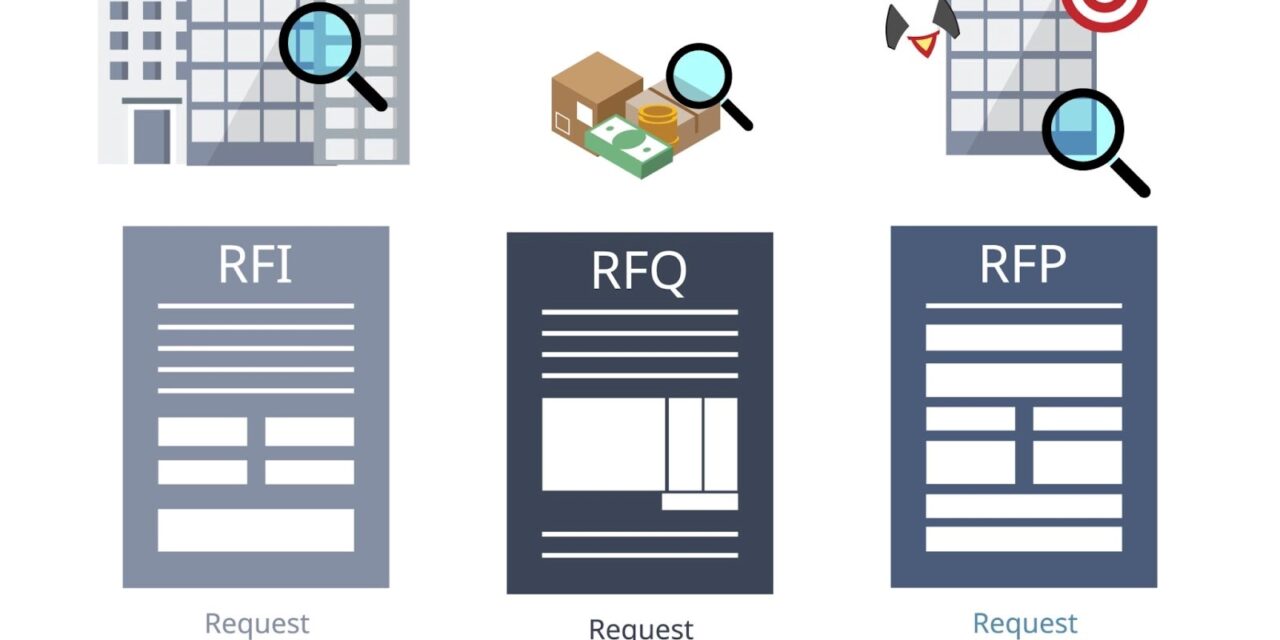In the dynamic landscape of business and procurement, acronyms like RFP, RFQ, and RFI are commonplace. These terms, standing for Request for Proposal, Request for Quotation, and Request for Information, respectively, play pivotal roles in the procurement process. If you find yourself navigating these waters for the first time or looking to deepen your understanding, this comprehensive guide is tailored for you.
Businesses often engage in complex transactions and collaborations, requiring a structured approach to procure goods and services. RFP, RFQ, and RFI are essential tools that facilitate this process, streamlining communication between buyers and potential vendors.
Request for Proposal (RFP)
A Request for Proposal, commonly known as an RFP, is a document that outlines the specific requirements, expectations, and criteria a buyer is seeking from potential suppliers. It is a formal invitation for vendors to submit proposals that detail how they would meet the buyer’s needs.
Key Components
1. Introduction and Background: Provides context for the RFP, including the buyer’s organization, the purpose of the procurement, and any relevant background information.
2. Scope of Work: Clearly defines the project or services required, including deliverables, timelines, and any specific conditions or constraints.
3. Evaluation Criteria: Outlines the factors that will be used to assess and compare proposals. This may include cost, technical expertise, experience, and other relevant criteria.
4. Submission Guidelines: Specifies the format, deadline, and any other requirements for submitting proposals.
5. Terms and Conditions: Details the legal and contractual aspects of the procurement, including payment terms, intellectual property rights, and other relevant conditions.
Use Cases
RFPs are commonly used for large and complex projects, where the buyer needs detailed proposals to make informed decisions. Examples include software development, construction projects, and consulting services.
Request for Quotation (RFQ)
A Request for Quotation, or RFQ, is a document that invites vendors to provide quotes for specific products or services. Unlike an RFP, an RFQ focuses primarily on pricing and other commercial terms.
Key Components
1. Product/Service Description: Clearly defines the products or services for which the buyer is seeking quotes, including any specific specifications or requirements.
2. Pricing Information: Requests detailed pricing information, which may include unit prices, bulk discounts, and any other relevant costs.
3. Terms and Conditions: Outlines the legal and contractual aspects of the transaction, including payment terms, delivery schedules, and warranties.
4. Submission Instructions: Specifies how vendors should submit their quotes, including the deadline and any required documentation.
Use Cases
RFQs are commonly used when the buyer has a clear understanding of their needs and is primarily focused on obtaining competitive pricing. This is often the case for standardized products or services.
Request for Information (RFI)
A Request for Information, or RFI, is a preliminary document used to gather information from potential vendors before a formal procurement process begins. RFIs are typically exploratory and help buyers understand the capabilities and offerings of potential suppliers.
Key Components
1. Introduction and Background: Provides context for the RFI, including the buyer’s organization and the purpose of seeking information.
2. Information Requested: Outlines the specific information the buyer is seeking, which may include details about the vendor’s capabilities, experience, and capacity.
3. Response Guidelines: Specifies how vendors should respond to the RFI, including any deadlines and preferred formats for providing information.
Use Cases
RFIs are useful when the buyer is in the early stages of planning a procurement and wants to gather information to inform their decision-making process. This can help identify potential vendors and understand the market landscape.
Choosing the Right Approach
Considerations
When deciding whether to use an RFP, RFQ, or RFI, consider the following factors:
1. Complexity of the Project: For complex projects with detailed requirements, an RFP is often more suitable. For straightforward transactions focused on pricing, an RFQ may be sufficient.
2. Stage of Procurement: If you’re in the early stages of exploring options and gathering information, an RFI can provide valuable insights before committing to a formal process.
3. Level of Detail Required: The level of detail needed in proposals or quotes will influence the choice between an RFP and an RFQ. More detailed requirements often warrant an RFP.
Best Practices
Regardless of the chosen approach, the following best practices can enhance the effectiveness of the procurement process:
1. Clear Communication: Clearly articulate your requirements, expectations, and evaluation criteria to ensure that vendors understand what is needed.
2. Transparency: Be transparent about the evaluation process and criteria to build trust with potential vendors.
3. Collaboration: Foster open communication and collaboration between the buyer and vendors to address any questions or concerns during the procurement process.
4. Flexibility: Be open to adjustments in response to vendor feedback, particularly in the early stages of the process.
Additional Insights
To further enrich your understanding of these procurement processes, let’s delve into some additional insights that can elevate your approach:
1. Technology Integration:
As technology continues to reshape industries, integrating digital tools into your procurement processes can enhance efficiency. Explore how e-procurement platforms and software solutions can streamline the creation, distribution, and evaluation of RFPs, RFQs, and RFIs.
2. Risk Mitigation:
Consider incorporating a robust risk management framework into your procurement strategy. Assess potential risks associated with each procurement method and develop contingency plans to mitigate these risks effectively.
3. Supplier Relationship Management:
Building strong and collaborative relationships with suppliers is essential for long-term success. Explore strategies for effective supplier relationship management, including regular communication, performance evaluations, and mutually beneficial partnerships.
4. Continuous Improvement:
Procurement is an iterative process, and organizations can benefit from a culture of continuous improvement. Regularly review and analyze past procurement experiences to identify areas for enhancement and implement changes that contribute to ongoing success.
5. Legal and Compliance Considerations:
Stay abreast of legal and compliance requirements relevant to your industry and region. Understanding the legal implications of procurement decisions is crucial for avoiding disputes and ensuring that your organization operates within the bounds of the law.
Conclusion
In the complex world of procurement, understanding the nuances of RFP, RFQ, and RFI is crucial for successful collaborations. By choosing the right approach and following best practices, both buyers and vendors can navigate the procurement process with confidence, fostering successful partnerships and achieving mutually beneficial outcomes.
Remember, each of these tools serves a specific purpose, and selecting the appropriate one depends on the unique needs and context of your procurement. Armed with this knowledge, you can approach your next procurement endeavor with clarity and confidence.
It’s important to underscore the significance of these procurement tools in shaping successful business partnerships. The ability to effectively utilize RFPs, RFQs, and RFIs empowers organizations to make informed decisions, optimize costs, and build relationships with vendors that align with their strategic objectives. In an ever-evolving business landscape, mastering these tools is not just a skill; it’s a strategic imperative.
In conclusion, the world of procurement is multifaceted, requiring a nuanced understanding of tools like RFP, RFQ, and RFI. As you navigate these processes, keep in mind that success goes beyond the completion of a transaction; it extends to the cultivation of enduring partnerships that drive mutual growth. By combining strategic thinking, effective communication, and a commitment to continuous improvement, organizations can position themselves for success in the intricate realm of procurement.












